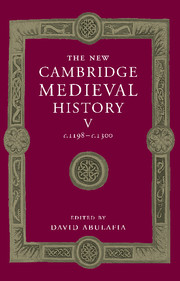Book contents
- Frontmatter
- Introduction
- Part I Common Themes
- Part II The Church in the Thirteenth Century
- Part III The Western Kingdoms
- Part IV Italy
- Part V The Mediterranean Frontiers
- Part VI The Northern and Eastern Frontiers
- 22 The Mongols and Europe
- 23 Scandinavia and the Baltic frontier
- 24 Eastern Europe
- 25 The Celtic lands of the British Isles
- Appendix Genealogical tables
- Primary sources and secondary works arranged by chapter
- Index
- Plate section
- Map 1 Europe in the thirteenth century
- Map 3 France, c. 1260
- Map 5 Germany and the western empire
- Map 6 Genoa, Venice and the Mediterranean
- Map 8 The Latin empire of Constantinople and its neighbours
- Map 10 Aragon and Anjouin the Mediterranean">
- References
22 - The Mongols and Europe
from Part VI - The Northern and Eastern Frontiers
Published online by Cambridge University Press: 28 March 2008
- Frontmatter
- Introduction
- Part I Common Themes
- Part II The Church in the Thirteenth Century
- Part III The Western Kingdoms
- Part IV Italy
- Part V The Mediterranean Frontiers
- Part VI The Northern and Eastern Frontiers
- 22 The Mongols and Europe
- 23 Scandinavia and the Baltic frontier
- 24 Eastern Europe
- 25 The Celtic lands of the British Isles
- Appendix Genealogical tables
- Primary sources and secondary works arranged by chapter
- Index
- Plate section
- Map 1 Europe in the thirteenth century
- Map 3 France, c. 1260
- Map 5 Germany and the western empire
- Map 6 Genoa, Venice and the Mediterranean
- Map 8 The Latin empire of Constantinople and its neighbours
- Map 10 Aragon and Anjouin the Mediterranean">
- References
Summary
THE RISE AND CHARACTER OF THE MONGOL EMPIRE
THE founder of the Mongol empire was a chieftain named Temüjin, who in the late twelfth century had become leader of one of a number of nomadic tribes which paid tribute to the Chin dynasty (1123–1234) in northern China. But within a few years the Mongols had subdued their pastoralist neighbours, notably the Tatars, the Kereyid (Kereit) and the Naiman; in 1206 Temüjin was proclaimed Chinggis Khan at an assembly (quriltai) representing the tribes of the eastern Eurasian steppe; and from 1211 he was at war with his former over-lord, the Chin emperor. By his death in 1227 his dominions extended from the Siberian forests to the Hindu Kush and from the Yellow Sea to the Caspian.
The Mongol empire rapidly evolved into more than just a confederacy of nomadic tribes as it incorporated semi-sedentarised and even settled elements: the Önggüd, inhabiting the intermediate zone between China and the steppe; the Khitan, semi-nomads in the region adjoining Manchuria; and the Uighurs, town-dwellers in the Tarim basin. The Khitan were remnants of an earlier imperial power which had reigned over Mongolia and part of northern China as the Liao dynasty until their overthrow by the Chin in 1125; under the form ‘Cathay’ (via the Arabic-Persian Khita), their name would later become current in the west for China as a whole. In their war against the Chin, the Mongols benefited from the assistance of Khitan officials and military units seeking to avenge the defeat of their forebears. The Uighurs too had been masters of an extensive steppe domain three centuries earlier, but had latterly been subject to the empire of the Qara (‘Black’) Khitan, founded by a fugitive Liao prince whose dynasty reigned over much of central Asia under the title of gür-khan (‘world ruler’). In 1218 the Qara Khitan empire, which had been taken over by one of Chinggis Khan’s enemies, the Naiman prince Küchlüg, was in turn incorporated in the Mongol dominions.
Keywords
- Type
- Chapter
- Information
- The New Cambridge Medieval History , pp. 701 - 719Publisher: Cambridge University PressPrint publication year: 1999
References
- 1
- Cited by



